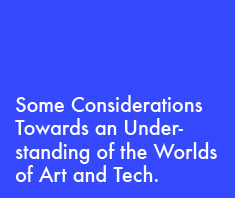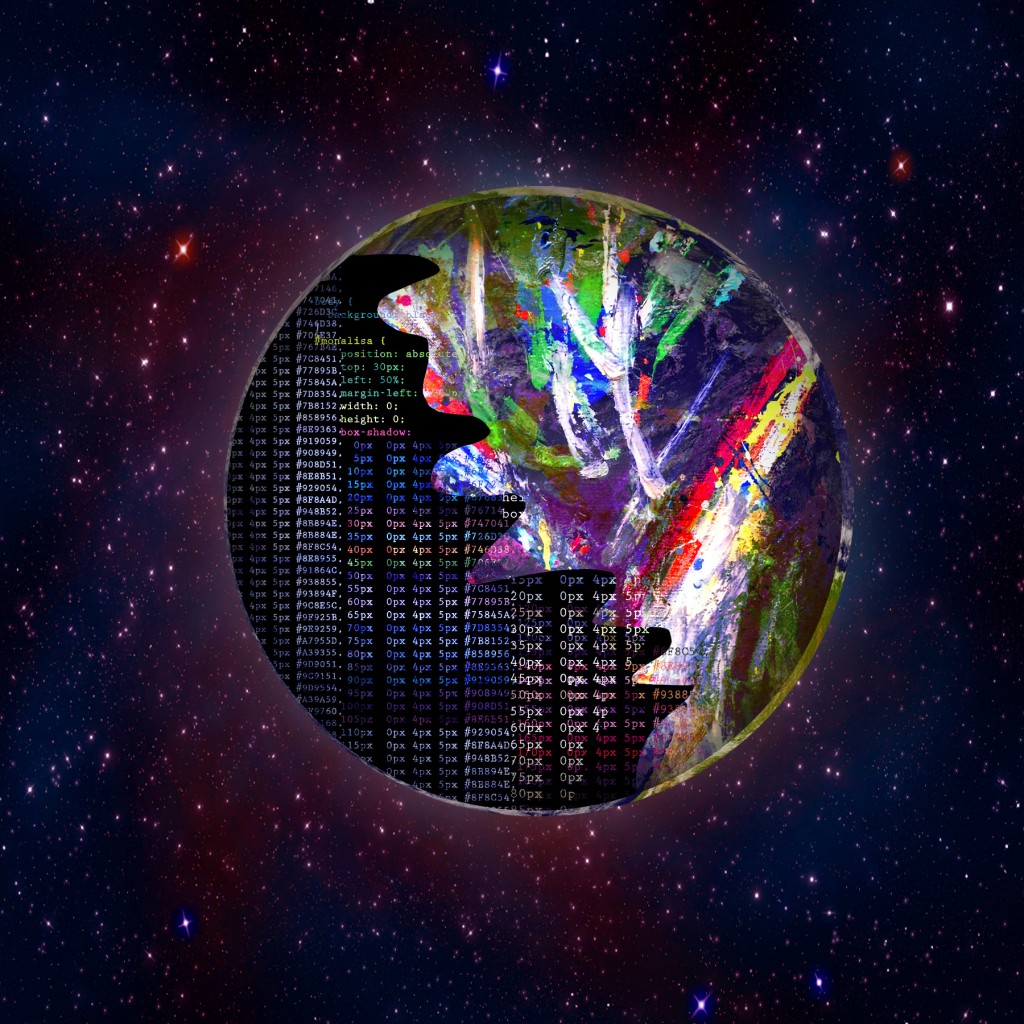This piece is selected from SFAQ Issue 15.
By Peter Dobey
In my last essay for San Francisco Arts Quarterly I attempted to articulate specific characteristics of contemporary art by observing particular events that made contributions towards defining visual art in the present tense. I elucidated three broad themes, the commercial, the political and the digital. Of the three, it is “digital” that presents the most interesting aesthetic problems, since it has the ability to be an art medium in its own right. Digital art, one of many ways to describe art made using new computer technologies, does not exist in a vacuum; it is part of a larger “tech” industry, movement and zeitgeist. It is part of a tech world.
Digital computer technology has profoundly altered the way we interact with, and make use of the world around us in nearly every aspect of life. To make use of the world around us involves some act of creativity, for when we are not engaging with the world at the level of habit or passive disinterestedness, we are actively inventing methods to know the world and to know ourselves. Indeed, we are always inventing new techniques (from techne the root word of tekhnologia) to better know our world. We do this instinctively, and at the same time, creatively.
It is my position that an artistic act possesses characteristics that transcend mere creativity. Artistic acts do not have a monopoly on creativity, but they do offer a particular kind of creative production that is particularly open ended to reception, and thus especially capable of provoking thought in the mind of the viewer that is not directed in any one given direction. The knowledge made available when looking at an art piece is not the same type of knowledge one obtains when memorizing multiplication tables, reading the instructions to build an Ikea bookshelf, or creating a Wikipedia page for that matter. There is no specific aim when acquiring knowledge through the viewing of art. Additionally, I maintain that some artistic acts are more artful than they are creative. For example, it is obvious to spot something in an art gallery that clearly looks as if it is art, but it is not very creative. One might judge this to be bad art, while the art object itself most likely does not possess the intentionality, or aim to be bad art. The viewing of art does not come ontologically stamped with intention.
One reason why it is important for thought to have no aim is because desire has no aim, once a desire is grasped, the desire is extinguished. Desire is metonymic; it jumps from one thing to the next. No desire is stronger than the desire for knowledge. Science works by extinguishing old problems in order to make new ones. Art makes old questions new again. Art does not present the kind of questions that are readily answerable, or accessible by going to the library, or picking up your smart phone to access a specific piece of information. Art is not readily consumable, it does not have the instant accessibility to its magic the way ubiquitous digital technology does, for example an iPhone App. I imagine this to be the case even if the artistic act was an iPhone App.
One of the reasons such technology as an Instagram filter has the ability to intrigue the masses is that it does not require extensive background knowledge for one to appreciate the creative acts it makes possible. This is why it is so thoroughly enjoyable. One does not need a background in art history to appreciate the magical way an everyday snapshot becomes picturesque when washed over with saturated hues. It is not an intellectual feat to appreciate an Instagrammed photo, as it is to appreciate a Duchamp urinal. An additional aspect of Instagram that makes it so enjoyable is the ability for creative acts to be shared with others without explanation. Everyone “gets” it.
This is not to say that the viewing of art is always an intellectual achievement and using and learning about digital technology is not. Besides, not everything needs to be an intellectual achievement. But the kind of intellectual achievement in viewing art is qualitatively different, and it is important to have access to both methods of thinking. Of course, there is art that, like the Instagrammed photo, does not require intellectual rigor. Works of art such as the Sistine Chapel or Beethoven’s 5th, are readily appreciated both for their “wow” factor or their historical/skilled significance. Much of the world’s music is wonderful because it can be mutually enjoyed from a place of undeveloped expertise or appreciated for its historical and technical virtuosity by a sophisticated listener.
A musical instrument is a technology, albeit a difficult one to learn to utilize.
The use of personal computers and their offshoots, what we colloquially call “tech,” has been engineered to be user friendly. That is, much digital technology has the intellectual background knowledge built in to its user interface. It is made with the unsophisticated user in mind. But then again, so is the pencil, which was upgraded only in 1858 to be a self-editing technology, when an eraser was attached to its end. A pencil can make art on its own, but the key is that the pencil is not art itself. It is a tool.
Art is not a tool. A tool is something that assists a particular task. A tool is something that can be used skillfully to make art, and one interesting outcome of art being made using new tech is that it may mean a return to an interest in skill.
Tools are used to make art, but art is not a tool on its own. If it were to be a tool at all, it would be a tool that does not know what its own use is. In the end, it is only the singular viewer of art that might ever know the use of a given art piece, and even then the viewer may not be conscious of any particular use, since the artwork in question is without an external use. Art is literally use-less.
Tech on the other hand, is very use-full. Even when tech facilitates the making of art, it tends have a utilitarian structure built into it. In short, tech does something. Art does no-thing. At least, no particular thing.
Still, artistic acts are recognized as such. This happens when there is a mutual agreement concerning the word “art,” so it follows that there is a shared conceptualization of art. To have a word for something is to have a concept and definition for it. Words are world creating, they are the bridge between thought and reality. When people say, “there is no definition of art,” what they mean to say is “there is no ONE definition of art,” for they have already defined art by using a word for it, namely “art.”
Art lives in a world. Art notoriously demands sophisticated background knowledge in order to be accessed and appreciated. Contemporary art is especially difficult to understand because it can be no other way; there are thousands and thousands of years of art that came before it. Paradoxically, the making of contemporary art does not necessarily require a sophisticated set of techniques in order to be considered art, often to the confusion of the lay art viewer. That is because it has been engineered that way. I do not believe the phrase “art world” is arbitrary, for it emphasizes the sociological and institutional nature of how art knowledge is distributed and organized.
For better or worse, the community of artists, curators, and art viewers that engage with the contemporary visual arts have engineered various rigid definitions of what is and is not contemporary art. Members of this community tend to inherently know what they are talking about when they use the word “art.” Again, this is because the word “art” has a shared particular meaning between speakers in this community. However, when the same people speak to friends and family outside of the contemporary art community about “art,” they are often met with bewilderment as to why they, the supposed art expert, have such a limited definition of art.
Members of the art world have a specialized discourse between each other, and so does the tech world.
There is however, a noticeable distinction between the natures of what is produced by these two worlds. The technology behind Instagram is sophisticated to make, but easy to use. A contemporary art piece can be either sophisticated or easy to make, but is always difficult to use (or view).
What the iPhone app and the contemporary art piece have in common, and this is a peculiarity of contemporary art that is not shared by earlier manifestations of visual art, is that the relative ease or difficulty that was involved in the making of either bears little on how the user or viewer experiences the end product. An Instagram snapshot you have taken of your friend can become an artful portrait with the touch of a filter button, even though you don’t know the underlying programming that allowed for this artful change to happen. In essence, it’s magic. Similarly, a urinal placed in a gallery magically becomes a piece of art by virtue of its surroundings and its historical status. Poof! Magic again.
The difference between the Instagram photo and the urinal? The magic of the urinal becoming art relies on a viewer possessing a background knowledge of attributes that determine the given conceptual properties the art piece is predicated on, and therefore can be considered and further defined by. The magic of Instagram does not require a background in computer engineering; its magic is built in. So then, why is the added difficulty needed to appreciate contemporary art important? After all, why do we need to know why something is cool or beautiful? It just is!
The contemporary art world itself is divided. Some members of its world think that’s enough. Others think beauty is not enough; they say an art piece must also be interesting. Further still, a common platitude is that “all that matters is if it is interesting or not.” I do not think this cuts the mustard. Art must be both.
I think life at its best is when it is beautifully interesting. Like true love, art appreciation does not come easily, and it does not come instantly. Sure, it may be a particularly exciting moment that starts love off, love at first sight. But one does not fall in love in one fell swoop; love has to be opened up. One must learn to love. The learning curve for loving contemporary art is incredibly steep. Popular tech on the other hand, is relatively easy to love, or at least fool around with.
There is an art world, and there is a tech world. I suggest they have much to learn from each other, and my hope is that they are at least in the courting phase and that sparks are starting to fly. But first they need to learn how to speak to each other, recognize each other’s differences and to learn to live with one another. They must learn how to speak each other’s languages.
The topic at hand is what do they have to learn from each other? Is this possible, and is there even a point? I for one have been wondering why the tech world, with all its money and power, has not yet proposed. Sure, both are at fault in their ambivalence towards one another, but it wouldn’t hurt for the tech world to pay the art world a little more attention once in awhile.
No less than two brand new art fairs will appear for the first time in Silicon Valley this year. “Silicon Valley Contemporary” takes place April 10th through 13th in San Jose, followed by “Art Silicon Valley” October 9th through 12th in San Mateo.
This is a chance for these two worlds to collide.
The next issue of SFAQ [May 1st release date] will examine art, tech and the worlds they inhabit in order to address and facilitate confluences between them.
Previous contributions by Peter Dobey:
–Art World in Review: L.A., Dave Hickey gets the ole’ once over from East Coast lurkers.
-The Art World in Review (12/23 – 12/29)




